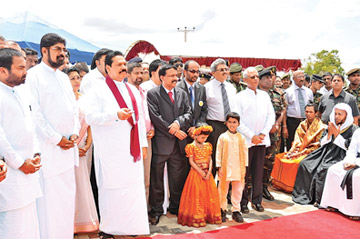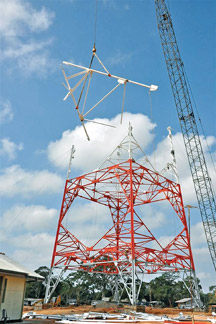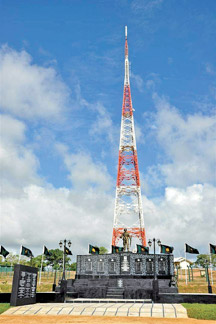A giant step for telecommunications
by Shirajiv Sirimane
|

President Mahinda Rajapaksa at the opening of the Kokavil Tower.
Minister of Telecommunication and Information Technology Ranjith
Siyambalapitiya, Minister of Mass Media and Information Keheliya
Rambukwella, Director General TRC Anusha Pelpita, Defence
Secretary Gotabaya Rajapaksa and President's Secretary Lalith
Weeratunga also took part in the event.
|
|

The tower being built |
One may still remember the huge 'half-brick' sized mobile phone which
was used by the elite in society some years ago. The ownership of one of
these cellular phones (commonly referred to as 'Celltel') in the early
1980s was considered a prestige and was almost on par with owning a BMW
or Mercedes Benz.
In the same era, owning a land telephone too was a luxury and people
had to wait for almost six months to obtain a connection. If a person
wanted to take an overseas call, he/she had to call the operator, give
the IDD number and wait by the telephone till this number was dialed by
the Operator.
Even calling a rural area was a long procedure. One had to place a
huge cash deposit to obtain International Direct Dialling facilities to
their mobile or land lines.
However, today, one can hardly find a person without a cellular
phone; Sri Lanka has over 17 million mobile users spread across five
networks and 3.7 million fixed lines including CDMA connections. Taking
an IDD call is simple; a user only has to dial five additional digits
and the charges too are affordable.
Today, though neighbouring countries manufacture missiles, try to
send astronauts to outer space and even possess nuclear energy, they
cannot match the connectivity that Sri Lankans enjoy. For some people in
Asia, it is still a luxury to own a mobile phone. Some wait months and
months to get a landline. The situation in some Asian countries is
similar to the Sri Lankan scenario, a decade ago.
Sri Lanka would soon enjoy 4G communication while the region is still
far behind, battling it for 2G frequency. It's noteworthy to mention
that Sri Lankans were covered by the 2G network in 1995 and had access
to 3G in 2006.
Director General Telecom Regulatory Commission (TRC) Anusha Pelpita
said the key to this remarkable development is the relaxing of
regulations and huge infrastructure investments made, not only by the
government, but also by the private sector.
The demand for a quality communication service by the educated
population of Sri Lanka too helped the country boast of an accolade the
region cannot match. Today, 93 percent of the population has access to a
communication device, which is an accolade, this takes the region closer
to its goal of being the Wonder of Asia.
Due to the 30-year conflict, this 'luxury', unfortunately, evaded the
North and the East and President Mahinda Rajapaksa was keen to breach
this gap.
Kokavil tower rebuilt
|

Kokavil tower |
President Mahinda Rajapaksa directed the TRC to reconstruct the
Kokavil tower so the people in the North too could enjoy the
communications benefits that are enjoyed by the other people in the
country.
The Mahinda Chinthana has also pledged to make Sri Lanka the Regional
Hub for Asian telecommunication networks. The construction of the
Kokavil multi-functional transmission tower is an important milestone on
the road to achieving this goal.
The Kokavil transmission tower was used in the past to serve the
radio broadcasting needs of the people in the region and the members of
the Security Forces serving in the Northern Province. During the
humanitarian operations Government troops recaptured the tower.
Multi-functional
President Rajapaksa at the opening of the tower emphasised that the
lives of the people in the North that were destroyed by terrorism will
get a boost in the same manner the Kokavil multi-functional transmission
tower was built, and with the commissioning of the tower, the right to
information of the people in the North, that was scrapped by the
terrorists, is guaranteed again.
The President pointed out that the destruction of the Kokavil Tower
interrupted the understanding between the people in the North and the
South, and allowed the terrorists to impart a distorted picture about
the people in the South in the minds of the youth in the North.
There was no means to change that distorted picture. President
Rajapaksa explained that the people of the North did not have the right
to information and speech, and they could open their mouths only to eat
and brush their teeth. “Today, they have all these rights," he said.
He said anybody could see that the misunderstandings which had
strengthened over 30 years were now changing. Last year, a Cabinet
meeting was held in Kilinochchi for the first time in Sri Lanka's
history. “He stated that the Cabinet meeting was held there to emphasise
that all parts of the country need to be equally developed.
A nation with a high density of telecommunication facilities would
always be a major attraction to investors and fulfilling this
requirement was another objective of constructing the Kokavil tower.
The tower will also be used to introduce digital radio and television
transmission using the Digital Video Broadcasting (DVB-T2) digital
terrestrial broadcasting standard to the entire Northern Province.
Several other towers have also been built in recent times, expanding
the telecommunication networks.
He said under the directions of the TRC and the Mass Media and
Information Ministry, the Central Engineering Consultancy Bureau played
a lead role in the restoration of the tower. “We are proud that this is
a 100 percent Sri Lankan product”' he said.
He paid tribute to Minister of Economic Development Basil Rajapaksa
and Minister of Mass Media and Information Keheliya Rambukwella. “We
also have to mention with gratitude the support extended by the Ministry
of Defence, the Sri Lanka Army and its Signals division,” he said.
Hot on the heels of the success of the Kokavil tower, the TRC is
embarking on another record-breaking project. This is to construct the
world's 20th tallest telecommunications tower in Peliyagoda;
construction would start next month.
The 350-metre Lotus Tower with an investment of US$ 103 million is to
be completed within 30 months.
The Chinese State company is expected to build this tower of which
the shape and appearance would be of a lotus. It will be on a 20-acre
land.
The first and second floors will be used for media broadcasting and
telecommunications systems. There will be four basement levels including
a shopping complex. It will also be a tourist attraction and a landmark
in the city,” Pelpita said. |

